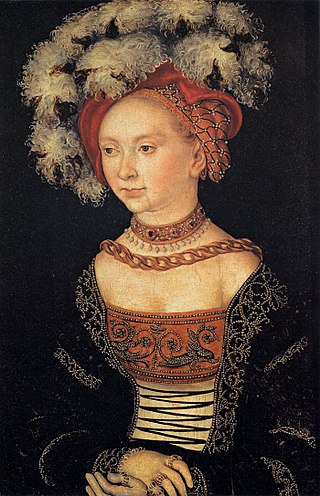
The Female Portrait is a painting by German Renaissance master Lucas Cranach the Elder, dating from around 1530, now housed in the Uffizi Gallery of Florence, Italy.

The Equestrian statue of Bartolomeo Colleoni is a Renaissance sculpture in Campo Santi Giovanni e Paolo, Venice, Italy, by Andrea del Verrocchio in 1480–1488. Portraying the condottiero Bartolomeo Colleoni, it has a height of 395 cm excluding the pedestal. It is the second major equestrian statue of the Italian Renaissance, after Donatello's equestrian statue of Gattamelata (1453).

The Castello di Bereguardo is a medieval castle located on Via Castello 2 in the town of Bereguardo, Province of Pavia, region of Lombardy, Italy.

St. Mark Preaching in Alexandria is an oil painting by Gentile and Giovanni Bellini, dated to 1504-1507, and held in the Pinacoteca di Brera, in Milan.
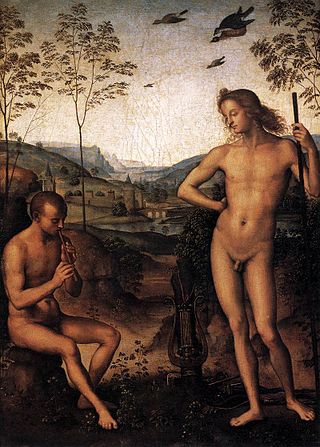
Apollo and Daphnis is a c.1483 mythological painting by Perugino. It was sold to the Louvre in Paris in 1883, where it still hangs and in whose catalogue it was known as Apollo and Marsyas. By the 1880s it had become misattributed to Raphael.

Nativity of the Virgin is a tempera on panel painting by the Master of the Osservanza Triptych, dated to around 1430-1435 and now in the Museo di palazzo Corboli in Asciano. It was inspired by Pietro Lorenzetti's 1335-1342 painting of the same scene. Its three lower panels show the Nativity of the Virgin, whilst the three upper panels show Death of the Virgin, Madonna of Humility and Burial of the Virgin.

Portrait of a Boy is a 1495 oil on panel portrait, which is currently being stored in the Minneapolis Institute of Art until January 2023. In the past it has been attributed to Lorenzo di Credi, Viti, Jacopo Francia, Raphael and others, but Giovanni Morelli's reattribution of it to Perugino is now widely accepted. Although the lack of a landscape background is unusual for this painter, the style is typical of his portrait technique.

Madonna and Child with St Herculanus and St Constantius or Madonna of the Kitchen is a 1515 painting by Perugino, now in the Galleria Nazionale dell'Umbria in Perugia. Its title refers to the fact that it once hung in the former kitchen of the Palazzo dei Priori in Perugia. The two accompanying saints are Herculanus and Constantius, both local saints to Perugia.
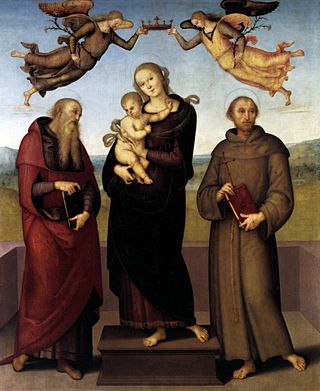
The Madonna of Loreto is a c.1507 oil on panel painting by Perugino, now in the National Gallery, London, which bought it in 1879. It shows the Madonna and Child flanked by Jerome (left) and Francis of Assisi (right). Two angels hover over Mary's head holding a crown. It reuses the low parapet from Madonna and Child with St Rose and St Catherine (1492) and probably also involved the master's studio assistants.

Saint Jerome in His Study is a c. 1445–1446 painting by Colantonio, a painter active in Naples between 1440 and around 1470. It shows the strong influence of contemporary Flemish and French art on the painter and originally formed part of a multi-panel altarpiece for the church of San Lorenzo Maggiore, later split up. The painting's dimensions are 151 centimetres (59 in) by 178 centimetres (70 in).

Portrait of Febo da Brescia is an oil-on-canvas painting created in 1543–44 by the Italian High Renaissance artist Lorenzo Lotto. It is identified with the commission mentioned in the artist's account books in April 1543 from Febo Bettignoli da Brescia, a nobleman from Treviso, for paintings of himself and his wife, which were delivered in 1544. After Febo's death in 1547 both paintings passed to his wife's heirs and remained with them until her family died out in the 19th century. In 1859, via the painter Francesco Hayez, the Pinacoteca di Brera in Milan acquired the portraits.

Portrait of a Thirty-Seven-Year-Old Gentleman is an oil-on-canvas portrait by the Italian High Renaissance artist Lorenzo Lotto, now in the Galleria Doria Pamphilj in Rome. It was previously interpreted as a 1517 self-portrait of the artist, but its style does not match Lotto's style of the 1510s. It is now dated to c. 1543 on the basis of stylistic similarities with works produced by the artist in the mid-1540s, such as Portrait of Febo da Brescia and Portrait of an Old Man with Gloves.
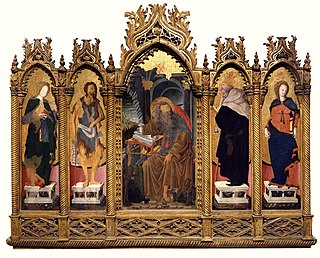
The Lazara Altarpiece is a 1449-1452 five-panel tempera on panel altarpiece by Francesco Squarcione, signed by the artist and now in the Musei Civici of Padua. It and his Madonna and Child are his only two definitively confirmed works.

Il Tramonto is an oil on canvas landscape painting by Giorgione, created c. 1505–1508, now in the National Gallery, London, which bought it in 1961.

Tobias and the Angel is an oil on canvas painting by Giovanni Girolamo Savoldo, created c. 1527. It is held in the Galleria Borghese, in Rome, since 1910. The Galleria's director Giulio Cantalamessa saw the work in a private house in Tivoli and corrected its misattribution to Titian. It hangs in the Sala dell Aurora.
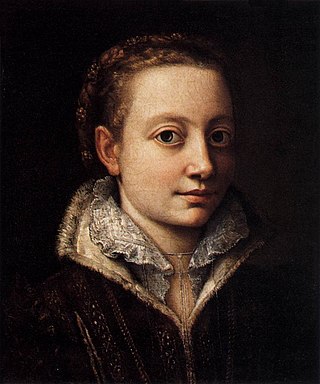
Portrait of Minerva Anguissola is a c. 1564 oil on canvas painting by Sofonisba Anguissola, now in the Pinacoteca di Brera in Milan.

Bust of Isabella of Aragon or Ideal Portrait of Laura is a marble sculpture by Francesco Laurana, now in the Kunsthistorisches Museum in Vienna. It is the only one of the artist's sculptures still to retain the coloured wax he applied to it. Its idealisation draws on the works of Piero della Francesca, which Laurana may have seen in Urbino, and leads some to identify it as an ideal portrait of Petrarch's Laura.

The monastery of Santa Maria Teodote, also known as Santa Maria della Pusterla, was one of the oldest and most important female monasteries in Pavia, Lombardy, now Italy. Founded in the seventh century, it stood in the place where the diocesan seminary is located and was suppressed in the eighteenth century.

Penitent Magdalene is a c. 1550 oil on canvas painting by Titian, now in the Museo di Capodimonte in Naples.

The Feast in the House of Simon the Pharisee is a c. 1545 is an oil on canvas painting by Romanino, now in the church of San Giovanni Evangelista in Brescia.




















